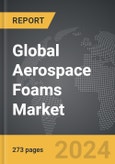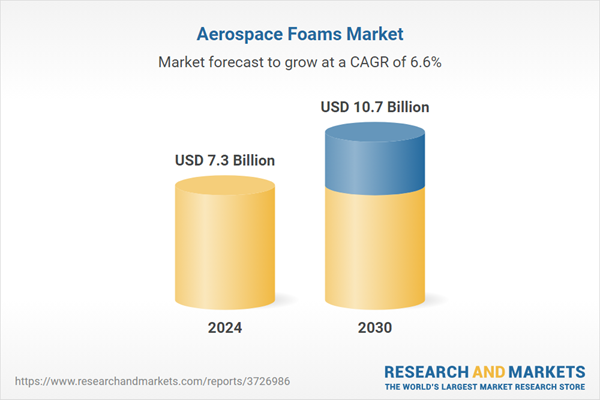Global Aerospace Foams Market - Key Trends and Drivers Summarized
In the aerospace industry, foam components play a vital role in enhancing both functionality and safety. These materials are integral not just for passenger comfort but also for critical functions within the structural framework of aircraft and spacecraft. Foam serves key purposes like vibration dampening, thermal insulation, and structural support, making it indispensable for the overall performance and efficiency of aerospace operations. The inherent properties of these foams - lightweight yet durable - allow them to contribute significantly to the overall safety and efficiency standards required in aerospace technology. As the industry continues to advance, the development of foam components remains complex and nuanced, necessitating a careful balance of lightweight properties and functional durability to meet the rigorous demands of aerospace environments.The adoption and integration of aerospace foams are driven by several key factors that underscore their growing importance in the industry. The aerospace sector's commitment to sustainability and reducing operational costs has led to an increased focus on lightweight materials such as aerospace foams. These materials significantly reduce the weight of aircraft, leading to improved fuel efficiency and lower carbon emissions. Furthermore, the superior impact resistance, thermal insulation, and sound absorption properties of aerospace foam enhance the safety and comfort of passengers and crew. Technological advancements in manufacturing processes, including additive manufacturing and nanotechnology, have expanded the applications of aerospace foam, making it possible to produce components that are both lighter and stronger. These innovations are crucial as they allow aerospace foams to meet the stringent requirements of modern aerospace engineering, contributing to enhanced performance and safety in flight.
Looking forward, the aerospace foam market is poised for significant growth due to several driving factors. The global expansion of the aerospace industry, spurred by increasing air travel demand and commercial aircraft production, directly influences the demand for aerospace foams. Regulatory compliance with safety and environmental standards further accelerates the adoption of these materials. Additionally, the ongoing modernization of aging aircraft fleets and the rising interest in space exploration create new avenues for the application of aerospace foams. These materials are increasingly used in the construction of spacecraft and satellites, where their ability to withstand extreme environmental conditions is crucial. The globalization of the aerospace supply chain and advancements in composite technologies also facilitate the broader use of aerospace foams, enhancing their utility in various aerospace applications. As the industry continues to evolve, aerospace foams remain at the forefront of materials technology, offering solutions that significantly contribute to the development of more sustainable, efficient, and safer aerospace vehicles.
Report Scope
The report analyzes the Aerospace Foams market, presented in terms of market value (USD). The analysis covers the key segments and geographic regions outlined below.- Segments: Material (Polyurethane (PU) Foam, Polyethylene (PE) Foam, Metal Foam, Polymethacrylimide (PMI) Foam, Other Materials); Application (Cabin Walls & Ceilings Application, Aircraft Seats Application, Aircraft Floor Application, Flight Deck Pads Application, Other Applications); End-Use (Commercial Aircraft End-Use, General Aviation End-Use, Military Aircraft End-Use).
- Geographic Regions/Countries: World; USA; Canada; Japan; China; Europe; France; Germany; Italy; UK; Spain; Russia; Rest of Europe; Asia-Pacific; Latin America; Rest of World.
Key Insights:
- Market Growth: Understand the significant growth trajectory of the Polyurethane (PU) Foam segment, which is expected to reach US$4.5 Billion by 2030 with a CAGR of 7.2%. The Polyethylene (PE) Foam segment is also set to grow at 6.6% CAGR over the analysis period.
- Regional Analysis: Gain insights into the U.S. market, valued at $2.2 Billion in 2024, and China, forecasted to grow at an impressive 8.3% CAGR to reach $1.2 Billion by 2030. Discover growth trends in other key regions, including Japan, Canada, Germany, and the Asia-Pacific.
Why You Should Buy This Report:
- Detailed Market Analysis: Access a thorough analysis of the Global Aerospace Foams Market, covering all major geographic regions and market segments.
- Competitive Insights: Get an overview of the competitive landscape, including the market presence of major players across different geographies.
- Future Trends and Drivers: Understand the key trends and drivers shaping the future of the Global Aerospace Foams Market.
- Actionable Insights: Benefit from actionable insights that can help you identify new revenue opportunities and make strategic business decisions.
Key Questions Answered:
- How is the Global Aerospace Foams Market expected to evolve by 2030?
- What are the main drivers and restraints affecting the market?
- Which market segments will grow the most over the forecast period?
- How will market shares for different regions and segments change by 2030?
- Who are the leading players in the market, and what are their prospects?
Report Features:
- Comprehensive Market Data: Independent analysis of annual sales and market forecasts in US$ Million from 2024 to 2030.
- In-Depth Regional Analysis: Detailed insights into key markets, including the U.S., China, Japan, Canada, Europe, Asia-Pacific, Latin America, Middle East, and Africa.
- Company Profiles: Coverage of players such as Armacell USA, BASF Corporation, Boyd Corporation, DuPont de Nemours, Inc., ERG Aerospace Corporation and more.
- Complimentary Updates: Receive free report updates for one year to keep you informed of the latest market developments.
Some of the 51 companies featured in this Aerospace Foams market report include:
- Armacell USA
- BASF Corporation
- Boyd Corporation
- DuPont de Nemours, Inc.
- ERG Aerospace Corporation
- Evonik Industries AG
- General Plastics Manufacturing Company
- NCFI Polyurethanesa Division of Barnhardt Manufacturing Co.
- NEVEON Holding GmbH
- Pyrotek Inc.
- Rogers Corporation
- Zotefoams Plc
This edition integrates the latest global trade and economic shifts into comprehensive market analysis. Key updates include:
- Tariff and Trade Impact: Insights into global tariff negotiations across 180+ countries, with analysis of supply chain turbulence, sourcing disruptions, and geographic realignment. Special focus on 2025 as a pivotal year for trade tensions, including updated perspectives on the Trump-era tariffs.
- Adjusted Forecasts and Analytics: Revised global and regional market forecasts through 2030, incorporating tariff effects, economic uncertainty, and structural changes in globalization. Includes historical analysis from 2015 to 2023.
- Strategic Market Dynamics: Evaluation of revised market prospects, regional outlooks, and key economic indicators such as population and urbanization trends.
- Innovation & Technology Trends: Latest developments in product and process innovation, emerging technologies, and key industry drivers shaping the competitive landscape.
- Competitive Intelligence: Updated global market share estimates for 2025, competitive positioning of major players (Strong/Active/Niche/Trivial), and refined focus on leading global brands and core players.
- Expert Insight & Commentary: Strategic analysis from economists, trade experts, and domain specialists to contextualize market shifts and identify emerging opportunities.
Table of Contents
Companies Mentioned (Partial List)
A selection of companies mentioned in this report includes, but is not limited to:
- Armacell USA
- BASF Corporation
- Boyd Corporation
- DuPont de Nemours, Inc.
- ERG Aerospace Corporation
- Evonik Industries AG
- General Plastics Manufacturing Company
- NCFI Polyurethanesa Division of Barnhardt Manufacturing Co.
- NEVEON Holding GmbH
- Pyrotek Inc.
- Rogers Corporation
- Zotefoams Plc
Table Information
| Report Attribute | Details |
|---|---|
| No. of Pages | 433 |
| Published | December 2025 |
| Forecast Period | 2024 - 2030 |
| Estimated Market Value ( USD | $ 7.3 Billion |
| Forecasted Market Value ( USD | $ 10.7 Billion |
| Compound Annual Growth Rate | 6.6% |
| Regions Covered | Global |









